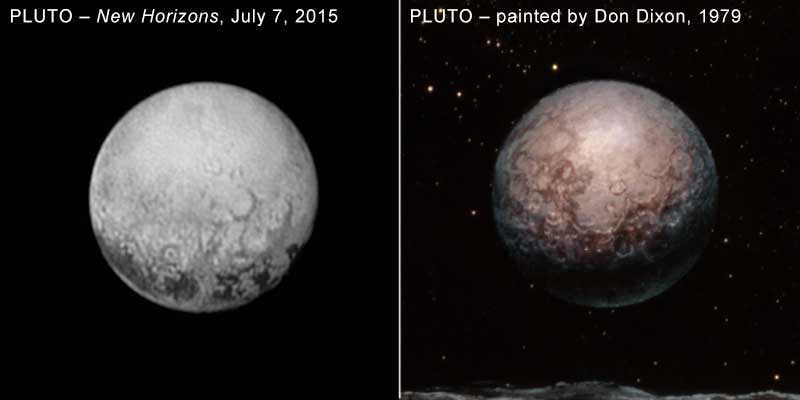Art World
NASA’s Latest Tweet of Pluto Looks Like This Painted Portrait From 36 Years Ago


Rain Embuscado

NASA’s New Horizons mission is a defining moment in space exploration. Despite myriad challenges, the space probe’s 9-year voyage will settle a plethora of questions about the dwarf planet and its five moons: How did it evolve? What are its terrains? And, of course, what does Pluto even look like?
Though high-resolution images aren’t slated for release until Thursday, July 16, NASA tweeted the latest photo of Pluto taken right before the flyby—and you won’t believe its resemblance to a space artist’s depiction of it from 36 years ago.

New Horizons image of Pluto / Don Dixon’s Painting of Pluto.
Photo: Courtesy of NASA / Don Dixon.
In 1979, astronomical artist Don Dixon painted a portrait of Pluto in the tradition of Chelsey Bonestell, whose dedication to scientific accuracy gained him recognition as an early pioneer of the art practice. On the subject of his painting’s striking resemblance to NASA’s recent photo, Dixon said:
I’d like to claim prophetic powers, but the painting was guided by the reasonable assumption that Pluto likely has a periodically active atmosphere that distributes powdery exotic frosts into lowland areas. The reddish color of the higher features is caused by tholins – hydrocarbons common in the outer solar system. The partial circular arcs would be caused by flooding of craters by slushy exotic ices. Pluto is apparently more orange than I painted it, however; I assumed the exotic ices would push colors more into the whites and grays.

Out of the Darkness.
Photo: via Amazon.
His guided creativity aside, the question stands: How did Dixon obtain such detailed information about Pluto over three decades ago?
It turns out Dixon might have had some help from Clyde W. Tombaugh, the American astronomer credited for discovering Pluto in 1930. His painting was used as the cover art for Tombaugh and Patrick Moore’s astronomy book Out of the Darkness: The Planet Pluto.
Tombaugh’s ashes are on-board New Horizons.